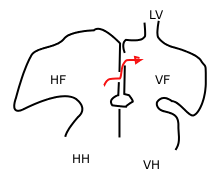Foramen secundum
(Redirected from Ostium secundum)
Foramen Secundum[edit | edit source]
The foramen secundum is an important structure in the developing heart of a fetus. It is part of the interatrial septum, which separates the right atrium from the left atrium. The foramen secundum plays a crucial role in fetal circulation, allowing blood to bypass the non-functioning fetal lungs.
Development[edit | edit source]
During fetal development, the septum primum forms first, creating a partial partition between the right and left atria. As the septum primum grows, it leaves a temporary opening called the ostium primum. As the septum primum continues to develop, the ostium primum closes, and a new opening, the foramen secundum, forms in the upper part of the septum primum.
The foramen secundum ensures that blood can continue to flow from the right atrium to the left atrium, bypassing the lungs, which are not yet in use. This is essential for proper fetal circulation, as the placenta is responsible for oxygenating the blood.
Closure[edit | edit source]
After birth, the foramen secundum, along with the foramen ovale, typically closes as the newborn begins to breathe air and the lungs become functional. The increased pressure in the left atrium causes the septum primum to press against the septum secundum, effectively sealing the foramen ovale and secundum. This closure forms the fossa ovalis in the adult heart.
Clinical Significance[edit | edit source]
In some cases, the foramen secundum may not close properly, leading to a condition known as a patent foramen ovale (PFO). A PFO can allow blood to flow between the atria, which may lead to complications such as stroke or migraines in some individuals.
Related Pages[edit | edit source]
Search WikiMD
Ad.Tired of being Overweight? Try W8MD's physician weight loss program.
Semaglutide (Ozempic / Wegovy and Tirzepatide (Mounjaro / Zepbound) available.
Advertise on WikiMD
|
WikiMD's Wellness Encyclopedia |
| Let Food Be Thy Medicine Medicine Thy Food - Hippocrates |
Translate this page: - East Asian
中文,
日本,
한국어,
South Asian
हिन्दी,
தமிழ்,
తెలుగు,
Urdu,
ಕನ್ನಡ,
Southeast Asian
Indonesian,
Vietnamese,
Thai,
မြန်မာဘာသာ,
বাংলা
European
español,
Deutsch,
français,
Greek,
português do Brasil,
polski,
română,
русский,
Nederlands,
norsk,
svenska,
suomi,
Italian
Middle Eastern & African
عربى,
Turkish,
Persian,
Hebrew,
Afrikaans,
isiZulu,
Kiswahili,
Other
Bulgarian,
Hungarian,
Czech,
Swedish,
മലയാളം,
मराठी,
ਪੰਜਾਬੀ,
ગુજરાતી,
Portuguese,
Ukrainian
Medical Disclaimer: WikiMD is not a substitute for professional medical advice. The information on WikiMD is provided as an information resource only, may be incorrect, outdated or misleading, and is not to be used or relied on for any diagnostic or treatment purposes. Please consult your health care provider before making any healthcare decisions or for guidance about a specific medical condition. WikiMD expressly disclaims responsibility, and shall have no liability, for any damages, loss, injury, or liability whatsoever suffered as a result of your reliance on the information contained in this site. By visiting this site you agree to the foregoing terms and conditions, which may from time to time be changed or supplemented by WikiMD. If you do not agree to the foregoing terms and conditions, you should not enter or use this site. See full disclaimer.
Credits:Most images are courtesy of Wikimedia commons, and templates, categories Wikipedia, licensed under CC BY SA or similar.
Contributors: Prab R. Tumpati, MD

